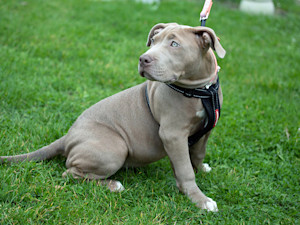A Complete Guide to Banned Dog Breeds in the UK
It’s not just the XL Bully that the government has banned
In this article:
List of banned dog breeds in the UK What is the criteria for banned breeds? The history of breed specific legislation in the UK What happens to banned breeds already in the UK? Criticisms and controversies relating to breed specific legislation Does breed specific legislation actually work? Will the ban eventually apply to Cane Corso or Presa Canaria Frequently asked questions Resources on breed specific legislation
For most dog lovers, the idea that any dog could be disliked – let alone outright banned – as a result of their breed is difficult to accept. But unfortunately that is the reality across many countries – including the UK. The Dangerous Dogs Act 1991opens in new tab came into force on 12 August 1991 in England, Wales and Scotland and has since prohibited “persons from having in their possession or custody” certain dog breeds. This act was created in response to a number of high-profile dog attacksopens in new tab on humans in 1991, seven of which were on children including a six-year-old who was attacked by a Pit Bull Terrier and taken to hospital with critical head and chest injuries.
The case, which followed 10 others in 1991 read out to Parliament by Bradford MP Bob Cryer, prompted the then Home Secretary Kenneth Baker to introduce a bill promisingopens in new tab “to rid the country of the menace of these fighting dogs”. Harsh words with devastating consequences for many dogs and their humans.
Get (totally free) deals for food, treats, accessories, tech and way more pet parenting must-haves.
Part of this legislation is known as breed specific legislation (BSL), which specifically names and bans five breeds. This approach has been called into question by animal charities such as the RSPCA who highlight the factopens in new tab that “there’s no robust research to demonstrate that these breeds or types are any more aggressive than other dogs”.
So, what are the banned dog breeds in the UK? And why are they illegal?
Banned dog breeds in the UK
Pit Bull Terrier
The Pit Bull Terrier (also known as the American Pit Bull Terrier) is one of the most widely recognised banned breeds in the UK. A medium-sized breed known for its muscular build and distinctive appearance, the historyopens in new tab of the Pit Bull Terrier traces back to the early 19th century in the UK. Pit Bulls were originally bred from Old English Bulldogs who gained their popularity in a cruel blood ‘sport’ known as bull baitingopens in new tab. One to two Bulldogs were set to harass a bull for hours, often in a fight to the death. These matches were held for the entertainment of the struggling classes as “a source of reliefopens in new tab from the tedium of hardship”.
Then, when the British Parliament enacted the Cruelty to Animals Act 1835, bull baiting was made illegal in the UK, and following this ban Pit Bulls were bredopens in new tab to take part in dog fights instead (held in a pit, hence the name). As a result, the breed gained a negative reputation, which many people now argue is unfairly based upon the fact their aggressive behaviour was encouraged through selective breeding and training for this purpose.
The breed was eventually brought to the US and there are many countries where Pit Bull Terriers are not banned and are instead recognised for their loving and loyal nature, making them excellent family pets when properly and responsibly trained and socialised. In fact, the American Canine Temperament Test Societyopens in new tab, which measures the temperament of breeds using a number of different criteriaopens in new tab (give it a read, it’s pretty interesting), lists Pit Bull Terriers as having a very stable temperament, with an 87.3 percent ‘pass rate’opens in new tab (for comparison, Golden Retrievers receive a score of 85.9 percent).
Japanese Tosa
The Japanese Tosa – often referred to as the Tosa Inu, Japanese Mastiff or simply Tosa – originated in Japan in the late 19th century. They were initially bredopens in new tab to be a larger, more powerful dog for fighting competitions, through a careful crossbreeding of native Japanese breeds with European Mastiffs, Bulldogs, Saint Bernards and Great Danes. The dogfighters in Japan wanted a dog that would fight in sumo-style wrestling, and they developed this breed for that purpose. As a result, they are heavy-set and because of rules in Japanese dog fighting where the dogs are not allowed to make a noise, they are also extremely quiet. This breed has not only been banned in the UK but in many other countries including Australia, France and Denmark.
Their inclusion in the UK’s banned breeds list reflects concerns over their fighting lineage and potential to harm if not managed by a responsible and experienced dog parent. In the US, the Japanese Tosa is not banned at the federal level but some cities and towns have breed specific legislation that restricts ownership.
The American Kennel Club, therefore, recognises the breed and describes themopens in new tab as “marked by patience, composure, boldness and courage. He is normally a tranquil, quiet and obedient dog, with a calm but vigilant demeanour. With a stately manner and robust build, they were formerly bred for fighting, but are now used as watchdogs”. It also scores them as extremely affectionate with their family and good with young children.
Dogo Argentino
As the name suggests, the Dogo Argentino was originally bred in Argentina. “Unlike many breeds that evolved organically to perform a certain function, the Dogo Argentinoopens in new tab was the result of a deliberate act of creation,” explains The American Kennel Club. In the mid-1920s, a young student named Antonio Nores Martinez set out with his brother to create the ultimate big-game hunting dog who could pursue wild boar and puma. They crossed the Cordoba (a master of fighting and hunting) with breeds such as Pointers for their scent skills, the Pyrenean Mastiff for their calm temperament, Boxers for their powerful jaws, and more. The result? A large, all-white, strong and powerful dog.
Their ban in the UK (and a handful of other countries including Australia and New Zealand) stems from concerns over aggressive tendencies, particularly when not adequately trained or socialised. They are however fiercely loyal and territorial, making them good watchdogs.
Fila Brasileiro
Also known as the Brazilian Mastiff, the Fila Brasileiro’s exact origins are unknownopens in new tab but experts believe they descended from European dogs brought to Brazil during the colonial period. Some possible ancestors include the English Mastiff, the Spanish Mastiff, the Rafeiro do Alentejo, and a type of Bulldog that existed in the 1400s.
The Fila worked on plantations and ranches, protecting livestock from large predators, protecting property and wrangling cattle. Due to this protective instinct, this large, powerful dog is banned in the UK due to its potential for aggression, particularly when it perceives a threat to its owner or property.
XL Bully
In a controversial move in 2023, the XL Bully joined the four other dog breeds banned under the Dangerous Dogs Act 1991. The XL Bullyopens in new tab, a breed with roots in the American Bully and American Pit Bull Terrier, is known for its powerful build and stature. When trained and socialised properly, these dogs can be one of the most loyal and affectionate breeds out there. However, due to their size and strength, if mishandled, they can also pose a risk to other dogs and members of the public.
The government sayopens in new tab the legislation is needed to protect the public from tragic dog attacks following “a concerning rise in attacks and fatalities caused” by XL Bully dogs. Many charities and dog parents disagree with the new laws.
Criteria for banned breeds
The UK’s Dangerous Dogs Act 1991 means it is against the law to:
sell a banned dog breed
abandon a banned dog breed
give away a banned dog breed
breed from a banned dog breed type
According to the legislationopens in new tab: “Whether your dog is a banned type depends on what it looks like, rather than its breed or name. For example, if your dog matches many of the characteristics of a Pit Bull Terrier, it may be a banned type.” To put it simply, the government classifies dogs as illegal based on their appearanceopens in new tab, rather than their breed, family tree, DNA or behaviour. The law speaks of the breed ‘type’ under legislation, which could include crossbreed dogs or even dogs that have a similar build. However, there is an element of common sense at play, and the government won’t be mistaking a Dachshund for a XL Bully. If you’re concerned, familiarising yourself with the government description of the banned breed typesopens in new tab will help to put your mind at ease.
Dogs that are suspected of being a banned type may be seized by the police and examined by an expert. If the dog is deemed to be a banned type and doesn’t have an exemption certificate, they can be killed, even if they haven’t behaved aggressively or injured anyone.
Some conditions that may apply to dogs that are not banned but are considered to be a ‘banned type’ include: being muzzled and on a lead in public, being neutered, being microchipped, being registered on the Index of Exempted Dogsopens in new tab (if your dog’s breed is banned but the court thinks it’s not a danger to the public, the court may put your dog on the Index of Exempt dogs and let you keep it), and having third-party insurance.
The history of breed specific legislation in the UK
The Dangerous Dogs Act 1991
The Dangerous Dogs Act 1991opens in new tab is an act created by the government and there are two main parts to it. Section 1opens in new tab is there to prohibit people from owning a dog belonging to certain breeds (or type) that had originally been bred for fighting. It also makes it illegal to sell, breed, give away or abandon one of these dogs. Section 2opens in new tab is about other dogs that might be a danger to the public but are not covered under the breed specific legislation, and Section 3opens in new tab states that it is a criminal offence for the owner or person in charge of any dog to allow the dog to be “dangerously out of control”.
Amendments and updates to the law
The Dangerous Dogs Act amendmentopens in new tab in 1997 relaxed the original ‘mandatory destruction order’, so that a dog found guilty of looking like a banned breed could be exempt if, having gone through the court system, they passed a behavioural assessment and their pet parents agreed to adhere to several strict rules, such as being neutered, microchipped (and with up to date information), have third-party insurance and be muzzled and on a lead at all times in a public place.
The pet parent had to be deemed to be a “right and proper person” (extremely subjective) to look after the dog, to make sure the dog was kept secured within their property, and to comply with the regulations.
In 2014, the law was amendedopens in new tab again to allow the court to decide that an otherwise non-dangerous dog could become dangerous if their human was not a “fit and proper person”.
In the same year, parliament removed the need for out of control behaviour resulting in injury to have to take place in public for it to be deemed illegal. It also extended the law to injuries caused to assistance dogs, in addition to those caused to people.
On 3 March 2015, The Dangerous Dogs Exemption Schemes (England and Wales) Order 2015opens in new tab was brought in, which allowed for exemptions from the immediate ‘destruction’ of a dog suspected of being prohibited under the Act.
Then, on 31 December 2023, a new set of regulations regarding XL Bully dogsopens in new tab came into effect in England and Wales making it an offenceopens in new tab to sell, abandon, exchange, give away, breed or have an XL Bully in public without a lead and muzzle.
And as of 1 February 2024, the second stage of the new regulations came into effectopens in new tab, making it an offence to even own an XL Bully unless you have a Certificate of Exemption. Without one, a pet parent faces a criminal record and fine, and the dog will be removed and potentially put down.
What happens to the banned breeds already in the UK?
If you have a banned dog, the police or local council dog warden can take them away and keep them, even if they’re not acting dangerously and there hasn’t been a complaint.
The police may need permission from a court to do this. A police or council dog expert will then judge what type of dog you have and whether it is (or could be) a danger to the public. Your dog will then either be released or kept in kennels while the police (or council) apply to a court.
If you have a valid Certificate of Exemption for your dog and they’ve not been acting dangerously, you may be able to keep it.
However, you cannot actually apply for a Certificate of Exemption (although trhere was a window to do so when they introduced the XL Bully ban), you’ll only have one if a court gave you one or you applied for one in the past. If you do have one, a Certificate of Exemption lets you keep a banned dog as long as it does not behave dangerously, and you follow certain rules. It is valid for the life of the dog.
Your dogs must be:
neutered
kept on a lead and muzzled at all times when in public
kept in a secure place so it cannot escape
As the pet parent, you must:
take out insurance against your dog injuring other people
be aged over 16
show the Certificate of Exemption when asked by a police officer or council dog warden, either at the time or within 5 days
let the Index of Exempt Dogs know if you change address, or your dog dies
Legal ramifications for dog parents
The responsibility falls to the pet parent to prove their dog is not a banned type. Which can be particularly hard when the type is seemingly not based on factual evidence at all but on ‘appearance’. If you can prove your dog is not a specific ‘type’, the court will order the dog to be returned to you. If you cannot prove it (or you plead guilty), you’ll be convicted of a crime.
You can get an unlimited fine or be sent to prison for up to six months (or both) for having a banned dog against the law. Your dog will also be put to sleep. If your dog is banned but the court thinks they’re not a danger to the public, the court may put your dog on the Index of Exempt dogs and let you keep them.
Controversies and criticisms
Rather than targeting specific breeds or types, many individuals and animal charities believe the law should tackle aggression on a case-by-case basis.
The Dog Control Coalition – which is made up of RSPCA, Blue Cross, Battersea, Dogs Trust, Hope Rescue, Scottish SPCA, The Kennel Club and British Veterinary Association – has long campaigned against banning specific types of dog, which it says fails as a solution to the problem.
In a statementopens in new tab released in light of the XL Bully ban, the Coalition said: “For 32 years, the Dangerous Dogs Act has focused on banning types of dog and yet has coincided with an increase in dog bites and the recent deaths show that this approach isn’t working. The UK Government must tackle the root issue by dealing with the unscrupulous breeders, who are putting profit before welfare, and the irresponsible owners whose dogs are dangerously out of control.”
Many people who oppose breed specific legislation argue that aggression is a learnt, not inherent, behaviour in dogs, and critics say there are no breeds predisposed to violence and that the act does nothing to deal with the root cause of dog attacks – the pet parents themselves.
“It’s punitive rather than controlling,” Trevor Cooper, a legal advisor to the Dogs Trust who specialises in dog law, told the BBCopens in new tab. “It tries to weed out certain types of dog but you can’t prejudge a dog’s behaviour. “It’s down to the way the dog has been brought up. There’s no point continuously punishing people without dealing with the actual cause.”
Not all animal rights advocates take this stance – some supporters of breed specific legislation, including PETAopens in new tab, see banning or restricting certain breeds as a way to reduce the need for animals to be put to sleep further down the line.
Does breed specific legislation actually work?
Despite the legislation, dog bites in the UK continue to increase. In fact, in 2023, police recorded 30,539 dog attacks in England and Wales, a 21 percent increaseopens in new tab from 2022; and according to the RSPCAopens in new tab, between 1989 and 2017, 48 people died in dog-related incidents, with 53 of the 62 dogs involved being dog breeds not on the banned breeds list. NHS dataopens in new tab also reveals a substantial increase in hospital admissions due to dog bites and strikes in England, from 3,377 incidents in 2000-01 to 8,758 in 2021-22, marking a significant 159 percent rise.
The University of Liverpool’s School of Veterinary Science conducted researchopens in new tab on the topic and stated: “There is little consistent scientific evidence that some breeds are inherently more aggressive than others. Our evaluations suggest that the breeds reported to bite are simply the most popular breeds in that region.”
The RSPCA explains that “aggressive behaviour can be influenced by factors such as how they’re bred, reared and experiences throughout their life. Breed isn’t a good way to predict risk of aggression”. Breed specific legislation therefore not only fails to protect public safety but has also resulted in the suffering and loss of hundreds of dogs.
A better approach
Many campaigners wish to see an end to legislation that singles out dogs based on looks alone and instead switches the focus to prevention. Charities and institutions, including the British Veterinary Associationopens in new tab, are continuing to call on the UK government to “repeal Section 1 of the Dangerous Dogs Act (1991) and prioritise an evidence-based, ‘deed-not-breed’ approach to dog control legislation. They say this can be achieved through:
Effective enforcement and consolidation of existing dog control legislation;
Commissioning additional research and establishing a centralised dog biting incident database to allow for more effective data recording; and
Promoting safe dog-human interactions and responsible ownership through education and campaign programmes.”
As Becky Thwaites, head of public affairs at Blue Cross says, “We need a piece of specific dog control legislation, enabling enforcers to step in and take action before dog attacks happen, as well as sufficient resources and training to allow them to do so.”
Will the ban eventually apply to Cane Corsos or Presa Canarias?
There is concern that other large breeds, such as the Cane Corsoopens in new tab and Presa Canaria, might also be banned; a concern that was spread following misleading information on a Facebook postopens in new tab in November 2023 suggesting that several large dog breeds may be “under threat” from the then incoming ban on XL Bully dogs in England and Wales. So it’s important to note that the UK government has saidopens in new tab that the ban on XL Bullies does not apply to other established breeds, including the Cane Corso and Presa Canaria. However, it has been speculated that the government is considering measures to address concerns that large breeds such as the Cane Corso could become popular alternatives to XL Bully-type dogs.
Frequently asked questions
What if I own a banned breed in the UK?
If you have a banned dog breed in the UK, the police or local council dog warden can take them away and keep them, even if they’re not acting dangerously and there hasn’t been a complaint. If you don’t have an Exemption Certificate, you could then potentially face an unlimited fine or be sent to prison for up to six months (or both) for having a banned dog against the law. Your best option is to seek legal advise on how to apply for an exemption at this late stage.
Are there any resources for current dog owners?
If you have an XL Bully, you can find more information on the RSPCA’s dedicated pageopens in new tab. The Dogs Trust also offers one-to-one muzzle trainingopens in new tab and has a behaviour support lineopens in new tab you can contact for advice.
Can you apply for an exemption?
You cannot apply for a Certificate of Exemption and the deadline has passed to register your XL Bully as exempt. You’ll only have one if a court gave you one or you applied for one in the past.
Resources
Dangerous Dog Act 1991opens in new tab
Ban on XL Bully dogsopens in new tab
XL Bully conformation standardopens in new tab
Controlling your dog in publicopens in new tab
Banned dogsopens in new tab
The history of the dangerous dogs actopens in new tab
Breed specific legislationopens in new tab
Numbers of dogs on the Index of Exempted Dogsopens in new tab














